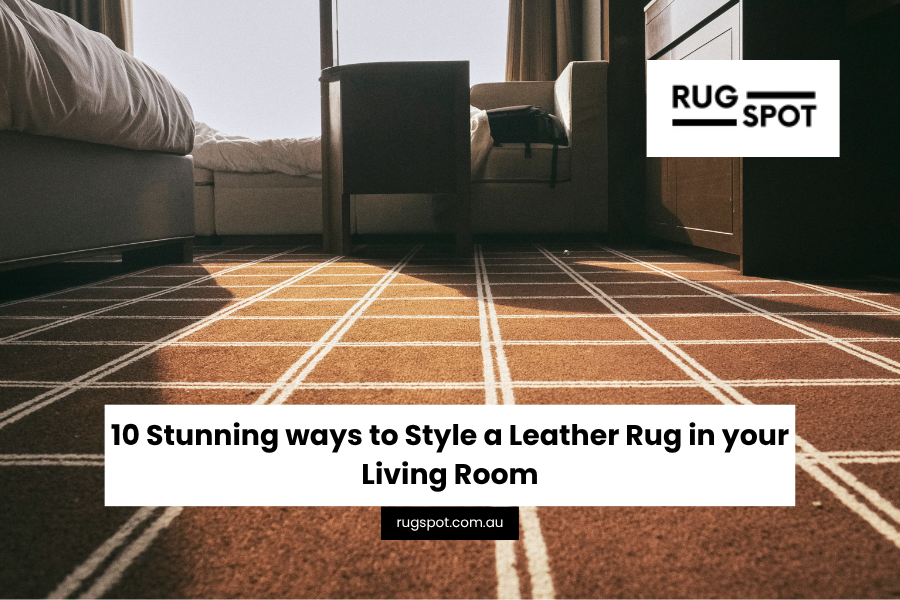How to Choose the Best Modern Living Room Rugs for Your Home
Introduction
Choosing the right living room rugs is essential to creating a space that feels comfortable, stylish, and cohesive. The living room is often the heart of the home, a place where families gather, guests are entertained, and relaxation takes place. A well-chosen rug can tie together all the elements of your room—furniture, decor, and flooring—while adding warmth, texture, and colour. Whether your living room has a modern, minimalist design or a more traditional feel, selecting the right rug will make all the difference in achieving a harmonious look.
With so many options available, picking the right living room rug can seem overwhelming. From different materials like wool, cotton, and synthetic fibres to varying patterns and sizes, there are many factors to consider. Additionally, each rug offers unique benefits, whether you’re looking for something durable for high-traffic areas or a soft, plush rug for added comfort. In Australia, where living rooms are often used as multifunctional spaces, it's important to select a rug that not only complements your style but also suits your lifestyle.
This article will guide you through the process of choosing the best modern living room rugs for your home. You’ll learn about different materials, styles, and sizes, and discover which types of rugs work best for Australian living rooms. By the end of this guide, you’ll have a clear understanding of what to look for when shopping for a living room rug, helping you make a well-informed decision that enhances the beauty and comfort of your space. Our goal is to provide you with practical tips that ensure your living room rug adds the perfect finishing touch to your home.
The Importance of Living Room Rugs
Rugs serve multiple purposes in any living room. They provide a visual anchor for the room, helping to define and separate spaces, especially in open-plan living areas. Additionally, living room rugs add a layer of comfort underfoot, softening hard floors and making the room more inviting. In homes with hardwood or tiled flooring, rugs help reduce noise by absorbing sound, making the living room feel more peaceful and relaxing.
1. Enhancing Aesthetics
The aesthetic impact of a rug cannot be overstated. A well-chosen rug can tie together the colour scheme and decor elements in the living room. It can be used as a statement piece to add a pop of colour or texture, or as a neutral backdrop that allows other design features to stand out. The rug’s design, whether it’s geometric, abstract, or plain, can completely transform the room’s vibe, making it feel modern, cosy, or eclectic, depending on your preference.
2. Adding Comfort
Comfort is one of the key reasons to invest in a living room rug. Thick, soft rugs provide a warm, cushioned surface that makes the room feel more comfortable, especially during cooler months. For families with children, a rug can also offer a safe, soft space for kids to play, protecting them from hard floors.
3. Defining Spaces
In open-plan homes, living room rugs play an important role in defining specific areas within a larger room. By placing a rug under a sofa set or coffee table, you can visually separate the living room from the dining or kitchen areas, creating a sense of order and structure in the space.
Choosing the Right Material
The material of a rug significantly impacts its look, feel, and durability. Each material offers different benefits, so it's important to choose one that suits your living room’s level of use and the overall aesthetic you want to achieve.
1. Wool Rugs
Wool rugs are a popular choice for living rooms due to their softness and durability. Wool is a natural fibre that provides excellent insulation, making it ideal for homes in colder climates. It’s also highly resilient, meaning it can withstand heavy foot traffic without losing its shape or softness. Additionally, wool rugs are naturally stain-resistant, making them a practical choice for busy households. Although wool rugs may cost more upfront, their durability and long-lasting quality make them a worthwhile investment.

2. Cotton Rugs
Cotton rugs offer a lightweight, affordable option for living rooms. They are easy to clean and maintain, making them a great choice for homes with children or pets. However, cotton rugs are not as durable as wool or synthetic fibres and may wear down faster in high-traffic areas. They are best suited for casual living rooms or areas with less foot traffic.

3. Synthetic Rugs
Rugs made from synthetic materials like polyester, nylon, or polypropylene are known for their affordability and durability. These rugs are often stain-resistant and easy to clean, making them a good option for families or households with pets. While synthetic rugs may not have the same luxurious feel as wool, they come in a wide variety of styles and colours, making it easy to find one that complements your living room decor.

4. Jute and Sisal Rugs
For those who prefer natural, eco-friendly materials, jute and sisal rugs offer a textured, organic look. These rugs are made from plant fibres, giving them a unique, rustic appearance. While jute and sisal rugs are durable and environmentally friendly, they are typically coarser underfoot and may not provide the same level of comfort as wool or synthetic rugs. They are best suited for casual or coastal-style living rooms.

Selecting the Right Size for Your Living Room Rug
Choosing the right size rug is crucial to achieving a balanced and cohesive look in your living room. A rug that is too small can make the room feel disjointed, while a rug that is too large may overwhelm the space.
1. Room Size and Furniture Layout
The size of the rug should complement the size of your living room and the layout of your furniture. A common rule is to choose a rug that fits under the front legs of your sofa and chairs, extending at least a few centimetres beyond the furniture. For larger living rooms, you may opt for a rug that fits under all the furniture, creating a unified seating area. In smaller living rooms, a medium-sized rug that sits just under the coffee table may be more appropriate.
2. Rug Placement
Consider where you want to place the rug in your living room. If your living room is part of an open-plan space, a large area rug can help define the seating area and create a sense of separation from the dining or kitchen areas. If you have a smaller living room, a smaller accent rug can add visual interest without overpowering the space.
Patterns and Colours for Modern Living Room Rugs
Rug patterns and colours play a significant role in determining the overall look and feel of your living room. The right choice can enhance your decor, while the wrong choice can clash with your furniture or colour scheme.
1. Neutral Tones
Neutral-coloured rugs in shades of grey, beige, or cream are versatile and can blend seamlessly with most decor styles. A neutral rug provides a calm, understated backdrop that allows other elements of the room, such as bold furniture or artwork, to take centre stage. Neutral rugs are particularly popular in minimalist and Scandinavian-style interiors.
2. Bold Colours
For those who want to make a statement, bold-coloured rugs in rich tones like navy, emerald, or terracotta can add a striking focal point to your living room. A bold rug can help create contrast in a room with neutral walls and furniture, adding energy and personality to the space.
3. Geometric and Abstract Patterns
Modern living room rugs often feature geometric or abstract patterns that add a contemporary edge to the space. These patterns can be subtle or bold, depending on the look you want to achieve. Geometric rugs work well in modern and minimalist living rooms, while abstract designs can add a touch of artistic flair to any space.
Caring for Your Living Room Rug
Once you’ve chosen the perfect living room rug, proper care and maintenance are essential to keep it looking fresh and clean. Different materials require different cleaning methods, so it’s important to follow the manufacturer’s recommendations for your specific rug.
1. Vacuum Regularly
To keep your rug free from dust and dirt, vacuum it regularly using a setting that is appropriate for the rug’s material. Be gentle with high-pile rugs to avoid damaging the fibres, and make sure to vacuum both sides of the rug if possible.
2. Spot Clean Spills
In the event of spills, blot them immediately with a clean cloth. Avoid rubbing the spill, as this can push the liquid deeper into the fibres. Use a mild detergent and water solution to gently clean the affected area.
3. Rotate the Rug
To prevent uneven wear, rotate your rug every few months, especially if it’s placed in a high-traffic area. This will help distribute foot traffic more evenly and keep the rug looking new for longer.
Conclusion: Enhance Your Home with the Perfect Living Room Rug
Choosing the right living room rug is a key part of creating a comfortable and stylish home. By considering factors such as material, size, pattern, and colour, you can find a rug that enhances your living room’s decor while providing comfort and durability. Whether you prefer the softness of wool, the affordability of synthetic fibres, or the natural look of jute, there is a modern living room rug that is perfect for your home.
This guide has provided you with practical tips on selecting the best rug for your living room, ensuring that you make an informed decision. With the right rug, you can create a space that feels inviting, cohesive, and perfectly suited to your lifestyle.
-------------------------------------------------------------------------------------------------------------
FAQ
1. What is the best material for a modern living room rug?
Wool, synthetic fibres (like polyester or nylon), and cotton are popular choices for modern living room rugs. Wool is durable and soft, while synthetic options are more affordable and easy to maintain. For a natural, eco-friendly choice, jute and sisal are great options.
2. How do I choose the right size rug for my living room?
Choose a rug that fits under the front legs of your sofa and chairs. In larger rooms, opt for a rug that fits under all the furniture to create a cohesive seating area. In smaller spaces, a medium-sized rug that sits under the coffee table works well.
3. What type of rug is best for high-traffic areas?
For high-traffic areas, consider a wool or synthetic rug. Wool is naturally durable and resistant to wear, while synthetic rugs like polyester and nylon are known for their resilience and stain resistance.
4. How do I care for my living room rug?
Vacuum your rug regularly to remove dust and dirt. Spot clean spills immediately with a clean cloth and mild detergent. Rotate the rug every few months to ensure even wear, and consider professional cleaning once a year.
5. Can a rug help reduce noise in my living room?
Yes, a thick rug can absorb sound and reduce noise in your living room. Rugs with a higher pile, like wool or synthetic shag, are particularly effective at dampening noise and making your space feel more peaceful.




